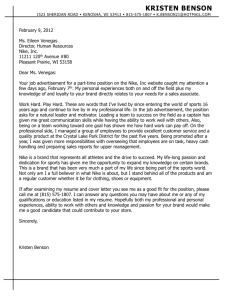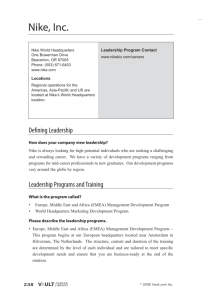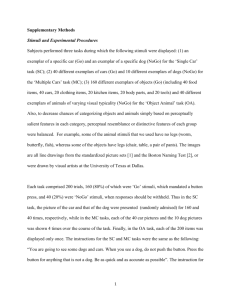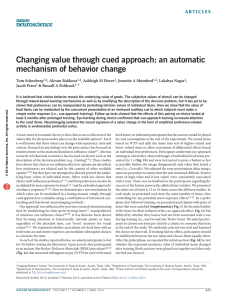Helena Tobin's Creative Portfolio
advertisement
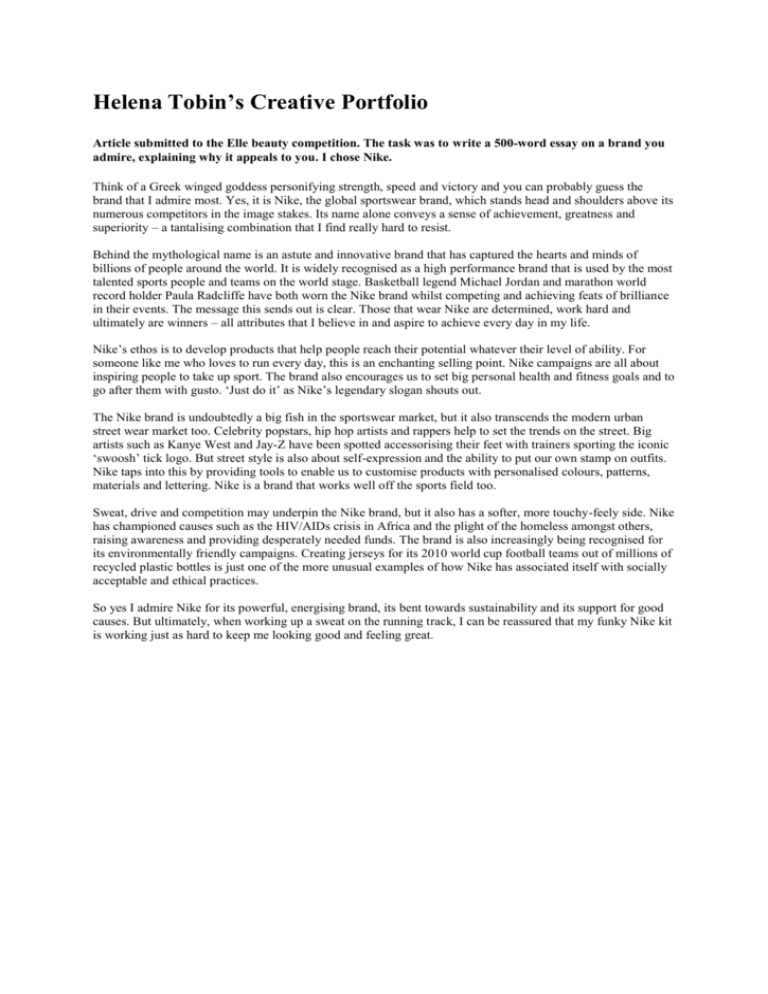
Helena Tobin’s Creative Portfolio Article submitted to the Elle beauty competition. The task was to write a 500-word essay on a brand you admire, explaining why it appeals to you. I chose Nike. Think of a Greek winged goddess personifying strength, speed and victory and you can probably guess the brand that I admire most. Yes, it is Nike, the global sportswear brand, which stands head and shoulders above its numerous competitors in the image stakes. Its name alone conveys a sense of achievement, greatness and superiority – a tantalising combination that I find really hard to resist. Behind the mythological name is an astute and innovative brand that has captured the hearts and minds of billions of people around the world. It is widely recognised as a high performance brand that is used by the most talented sports people and teams on the world stage. Basketball legend Michael Jordan and marathon world record holder Paula Radcliffe have both worn the Nike brand whilst competing and achieving feats of brilliance in their events. The message this sends out is clear. Those that wear Nike are determined, work hard and ultimately are winners – all attributes that I believe in and aspire to achieve every day in my life. Nike’s ethos is to develop products that help people reach their potential whatever their level of ability. For someone like me who loves to run every day, this is an enchanting selling point. Nike campaigns are all about inspiring people to take up sport. The brand also encourages us to set big personal health and fitness goals and to go after them with gusto. ‘Just do it’ as Nike’s legendary slogan shouts out. The Nike brand is undoubtedly a big fish in the sportswear market, but it also transcends the modern urban street wear market too. Celebrity popstars, hip hop artists and rappers help to set the trends on the street. Big artists such as Kanye West and Jay-Z have been spotted accessorising their feet with trainers sporting the iconic ‘swoosh’ tick logo. But street style is also about self-expression and the ability to put our own stamp on outfits. Nike taps into this by providing tools to enable us to customise products with personalised colours, patterns, materials and lettering. Nike is a brand that works well off the sports field too. Sweat, drive and competition may underpin the Nike brand, but it also has a softer, more touchy-feely side. Nike has championed causes such as the HIV/AIDs crisis in Africa and the plight of the homeless amongst others, raising awareness and providing desperately needed funds. The brand is also increasingly being recognised for its environmentally friendly campaigns. Creating jerseys for its 2010 world cup football teams out of millions of recycled plastic bottles is just one of the more unusual examples of how Nike has associated itself with socially acceptable and ethical practices. So yes I admire Nike for its powerful, energising brand, its bent towards sustainability and its support for good causes. But ultimately, when working up a sweat on the running track, I can be reassured that my funky Nike kit is working just as hard to keep me looking good and feeling great. Article submitted to the Daily Telegraph Young Science Writer Awards that received a Highly Commended certificate Warning: This is a Nogo area Next time you cut or graze your skin, admire how your body goes about the repair of the damage. It is an intricate job carried out by the maintenance department of your organs, tissue and peripheral nervous system that is often take for granted. Subsequently, when a thousand people every year in the UK injure the nerves in their spinal cord, along with the many others who suffer Alzheimer and stroke damage to the neural system of the brain, we wonder why the maintenance departments in these areas of the body are stopped from repairing and preventing the permanent disability caused by these injuries. The edge of this puzzle was completed back in the 1980s when it was discovered that nerves from the brain and spinal cord, collectively known as the central nervous system, could grow on cells from other parts of the body, but not in their natural cellular environment. This suggested that a nerve in the brain or spinal cord has the potential to grow but its development is halted by stop signals. Since then further progress has been made with the puzzle, with many of the inhibitory molecules being isolated and characterised, and yet one major perpetrator has remained elusive until now. A research group from SmithKline Beecham have recently been involved in a project to collar the mysterious inhibitory molecule given the name "Nogo", traced in other animals but never identified in humans. By using clues in cow DNA sequences, which are the instructions for the building of Nogo proteins, a computerised database of similar human DNA sequences was searched to produce an identity parade of likely suspects. From this line-up, the human Nogo gene sequence was isolated, cloned and inserted into cells that would manufacture the protein. The definitive evidence confirming suspicions that the newly produced protein was indeed Nogo came when a plate of branching neurons were stopped from extending by the addition of the suspect protein. This proved that Nogo, encoded by the guilty DNA message, was a "potent inhibitor of neurite outgrowth. Steve Moore, the team leader of the Nogo project, is clearly pleased with this discovery, and said that "It's always exciting and gratifying to get the first functional data". Nogo is expressed in the neighbours of nerves called oligodendrocytes. These are cells in the brain and spinal cord that form a myelin sheath, which is an electrical insulating layer of cells that wraps around nerve fibres in the same way that plastic covers wires. The Nogo molecules discovered in this layer of cells are there to make sure that the intricate system of neurons, like the complex circuitry of a telephone exchange, form and maintain correct connections. It is fair to say that Nogo is not the first molecule discovered that inhibits in this way. In fact, Steve Moore was quick to point out that "Nogo is but one of a number of inhibitory molecules", and any treatments encouraging the regeneration of damaged nerves will have to deal with most of them. However, he also adds that it's "a major one and of considerable importance" and that it "rates alongside the other major inhibitory factor, myelin associated glycoprotein" - or MAG for short. The race is now on to find the Nogo receptor, the protein attached to nerve cells with which the Nogo molecule binds to and transmits its inhibitory message. "This will be the area where possible therapeutic intervention arises," said Moore. It is conceivable that by blocking this receptor or stopping Nogo from reaching this target, its inhibitory effect could be broken down. Researchers are still a long way off winning the war against brain and spinal injury, and the Nogo discovery is just another battle won in the fight to gain full recovery of nerve function after injury. Nevertheless, it is a step in the right direction, both for opening up new lines of medical research in this area and providing new hope for those paralysed.
